7 Ways Music Can Support Autistic Children
Music can be a powerful tool for emotional and physical development in children.
Making music offers opportunities to improve communication. Our child can express emotion through the noises that they make, and we can practice back and forth exchanges, turn-taking and listening skills by making sounds together.
Using musical instruments can be beneficial physically, improving breathing and fine and gross motor skills. Playing some instruments – for example a drum – offers beneficial proprioceptive feedback.
Music can also help regulate the nervous system. Slow, soft music and sounds are calming and can ease anxiety, while loud, up-tempo music is alerting, which helps an under-stimulated nervous system. Many children will enjoy listening to music through headphones, as the vibrations by the ears feels pleasurable.
Our child may have emotional responses to certain pieces of music, which can help them develop emotional literacy. They can use it as a tool to help them self-regulate, calm down or express anger or excitement.
While many Autistic children have sensory issues and can be sensitive to noise, most can enjoy music and music-making, provided it is approached on their terms and in a setting that feels safe.
If our child is wary around music it is important to be sensitive about their anxieties. While some types of sound may cause distress, others can feel really lovely. It’s worth persevering gently over time to discover our child’s preferences. See our sensory processing pages for more.
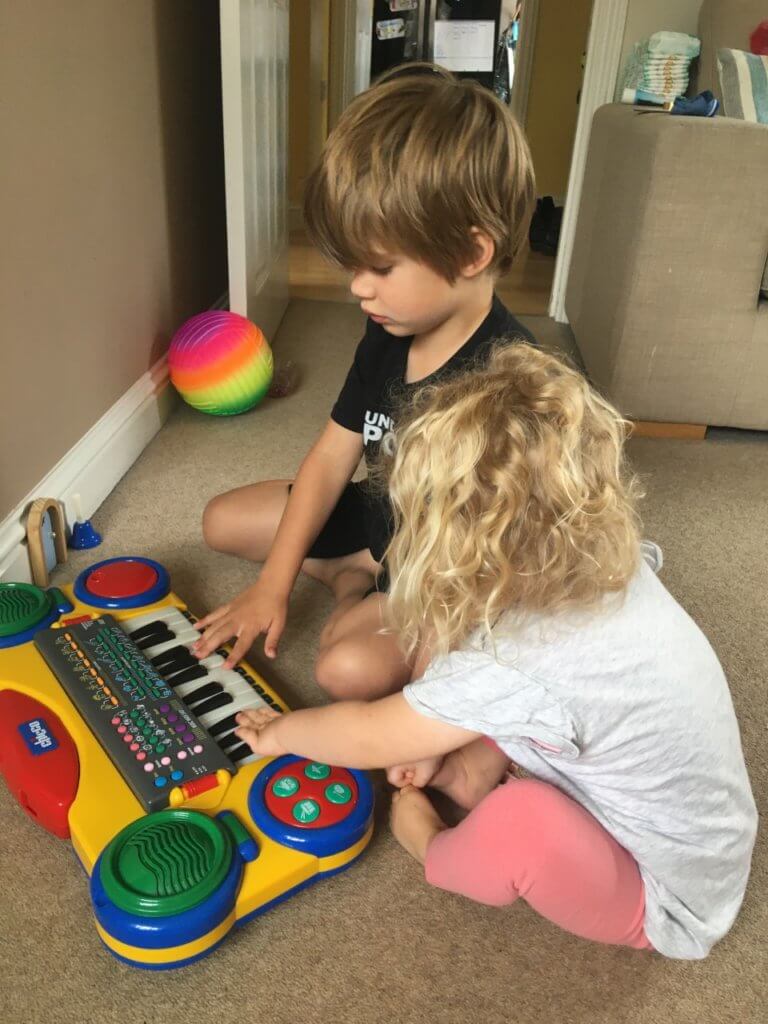
Musical Ideas to try at Home
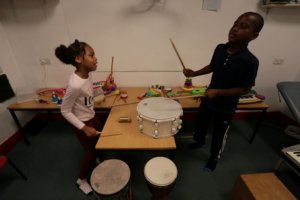
Many children enjoy playing with musical instruments. They’re accessible, interactive, and provide fantastic ’cause and effect’ feedback. We don’t need to be skilled in playing an instrument to enjoy the sounds we create by using it.
If we don’t have any instruments at home we can make our own using everyday objects. A wooden spoon and some upside down saucepans can become a drumkit, and a plastic bottle with some rice in it makes a great shaker. Check out this blog post for some other easy DIY instrument ideas.
Blowing works the mouth and shoulder stability muscles to help develop breathing control.
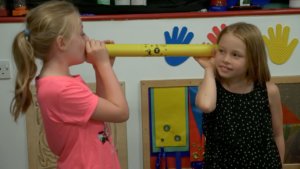 Taking deep breaths can also help to slow the heart rate and can be used to teach children how to calm themselves when becoming anxious or irritable. Mindfulness, yoga, pilates and relaxation approaches all use breath control as a means of control and self- regulation.
Taking deep breaths can also help to slow the heart rate and can be used to teach children how to calm themselves when becoming anxious or irritable. Mindfulness, yoga, pilates and relaxation approaches all use breath control as a means of control and self- regulation.Blowing a whistle, harmonica, recorder or party blower are fun (and noisy!) ways to start developing breath control, and offer brilliant cause and effect feedback. Brass and wind instruments offer even more resistance.
If we don’t have these instruments available at home (or want a break from the noise!), blowing through a straw offers similar development opportunities. We can make a game out of it to make it fun for our child. Can they blow paper shapes or cotton wall across the table, or take us on at a game of blow football? Can they blow into some soft therapy putty hard enough to create a bubble? How about bubble painting? Blow into a basin of washing up liquid/bubble bath to make lots of bubbles; make it more visually exciting by adding food colouring or paint to the mix. Then paint with the bubbles!
Singing songs while you do actions with your child is a great way to warn them of what is to come as well as giving different cues to match movement with communication which can help with their understand and following instructions.
For example:
When the Grand Old Duke’s men go ‘up’ you can all stand or put your arms up in the air. When he goes down you can sit down or put your arms down.
‘Row row row the boat’ – this is great to stretch out hamstrings in long sitting.
‘This is the way we touch our toes, touch our toes, touch our toes, this is the way we touch our toes on a cold and frosty morning’ can be adapted to encourage a child to do all kinds of movements and activities. i.e. ‘This is the way we brush our teeth’ or ‘this is the way we eat our food’ etc.
‘5 Little Monkeys Bouncing on a Bed’ – for jumping and moving games.
‘When you’re happy and you know it….’ You can use this to talk about any activity – move your arm, open your hands, jump up and down etc.
‘This little piggy went to market’ when you are massaging or stretching fingers.
Songs can be a clear indication of the start of an activity or the end so that, when regularly used, children know what is coming next. For example Mr Tumble’s Hello and Goodbye songs (CBeebies: Something Special – Hello Song; CBeebies: Something Special – Goodbye Song) can be used at the beginning and end of an activity, or first thing in the morning and last thing at night.
You can also use the same song to help your child manage an activity they are not hugely keen on. For example you could sing ‘twinkle twinkle little star’ while you give your child a stretch, or brush their hair or teeth. If your start and end the activity as you start and finish the song, your child will know how long the activity will be going on for, and when the end is near. This will make the whole process easier for them.
YouTube is bursting with music videos that children can sing and dance to. The Little Baby Bum channel for example has hours and hours of nursery rhymes and children’s songs with cartoon characters.
CBeebies Songs has a huge library of songs with everything CBeebies, from Something Special to Andy’s Dinosaur Adventures. There should be something for everyone to enjoy and hopefully move and sing along to.
Curly Cath has lots of wonderful videos to help children sing, dance and make music. The videos are aimed at under fives but may also be suitable for older children with learning difficulties.
Flamingo Chicks have produced an amazing series of inclusive dance videos, with Makaton signing and adaptations for different needs and with a different theme for each session. This Inclusive Space Dance Class is great example of their work. Do visit their YouTube channel for more.
Over lockdown, Bristol Bears ran a wonderful weekly “DanceTime” dance session for those with profound learning needs. You can find the videos on their YouTube channel.
We love this series of bite-sized creative dance sessions from Wriggle Dance Theatre. The instructions are clear and children are given plenty of opportunity to be creative.
Just Dance Kids is a great game where children can enjoy learning dance routines to well known songs. You don’t need a gaming system to enjoy the Just Dance experience – there are plenty of videos on YouTube children can dance along to. Repetition can be key with these. Find one song that your child especially likes, and help them learn the movements. Over time your child may learn the routine so well they can anticipate the next move, which can rewarding and enjoyable. If that isn’t motivating, they can of course just freestyle too! You can make Just Dance part of your day-to-day routine as a way of getting a daily workout in for your child (and maybe you too!).
Soundabout have produced some lovely videos for children with learning difficulties. They encourage children to sing, play and make music and sounds any way they can.
Singing Hands have created this excellent library of popular songs and nursery rhymes all sung using Makaton.
You can also use singing as a way to prompt communication yourself. Sing most of a very familiar or favourite song but leave out the words at the end of the line for your child to fill in with words or noises.
We have found five great musical apps that you can download for your child.
Sensory Soundbox (£2.99 – Apple). Just a touch on the screen produces a wide variety of sounds and noises. As you move your fingers across the screen, the noises change. App can be calming or stimulating,
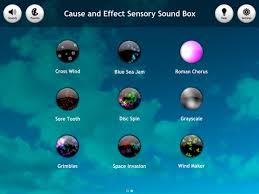 depending on the setting and offers wonderful cause and effect feedback.
depending on the setting and offers wonderful cause and effect feedback. Baby’s Musical Hands (free – Apple/Android). A colourful musical app – any touch will play a piano sound.
Finger paint (free – Apple/Android).
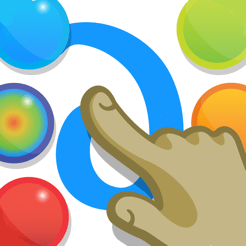 Paint with different colours and sounds.
Paint with different colours and sounds. Baby Mozart (free – Apple/Android). Plays different relaxing music including instrumental, nursery rhymes and white noise. Also includes some funny noises and flashcards too.
Musical Me! (free – Apple). Several simple music games aimed at young children with early developing pointing finger control.






